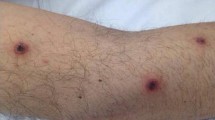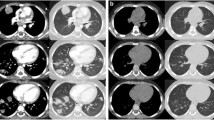Abstract
Alternaria spp. have emerged as opportunistic pathogens particularly in immunosuppressed patients, such as bone marrow transplant recipients. The authors present a case of Alternaria alternata in a patient with Fanconi’s anemia, who received antifungal prophylaxis with posaconazole after an unrelated bone marrow transplantation, followed by empirical antifungal treatment with caspofungin when persistent fever emerged until cutaneous lesions eventually appeared. At that time there were clinical reasons to assume that the patient had an infection with an emerging fungus. This consideration triggered a change of the antifungal therapy from caspofungin to liposomal amphotericin B. After collecting sufficient evidence for the presence of an invasive fungal infection by A. alternata and given the severity of neutropenia and other immunosuppression, oral posaconazole was added to liposomal amphotericin B. The course of disease in this case suggests a possibly synergistic interaction between liposomal amphotericin B and posaconazole when administered simultaneously to treat an invasive systemic infection by Alternaria spp. in immunocompromised patients.






Similar content being viewed by others
References
Pastor FJ, Guarro J. Alternaria infections: laboratory diagnosis and relevant clinical features. Clin Microbiol Infect. 2008;14:734–46.
Bartolome B, Valks R, Fraga J, Buendía V, Fernández-Herrera J, García-Díez A. Cutaneous alternariosis due to Alternaria chlamydospora after bone marrow transplantation. Acta Dermatol Venereol. 1999;79:244.
Sood N, Gugnani HC, Guarro J, Paliwal-Joshi A, Vijayan VK. Subcutaneous phaeohyphomycosis caused by Alternaria in an immunocompetent patient. Int J Dermatol. 2007;46:412–3.
Morrison VA, Weisdorf DJ. Alternaria: a sinonasal pathogen of immunocompromised hosts. Clin Infect Dis. 1993;16:265–70.
Boby BA, Sabio H, Johnson CE, Kahn J, Hanna MD. Alternaria infection with a patient with acute lymphocytic leukaemia. Pediatr Infect Dis J. 1987;6:418–20.
Dodds-Ashley E. Management of drug and food interactions with azole antifungal agents in transplant recipients. Pharmacotherapy. 2010;30:842–54.
Disclosures
This manuscript has been published in a journal supplement that was created with an unrestricted educational grant from Gilead Portugal. The authors have no conflicts of interest to declare.
Author information
Authors and Affiliations
Corresponding author
Rights and permissions
About this article
Cite this article
Ferreira, I.d.S., Teixeira, G. & Abecasis, M. Alternaria alternata Invasive Fungal Infection in a Patient with Fanconi’s Anemia after an Unrelated Bone Marrow Transplant. Clin Drug Investig 33 (Suppl 1), 33–36 (2013). https://doi.org/10.1007/s40261-012-0018-0
Published:
Issue Date:
DOI: https://doi.org/10.1007/s40261-012-0018-0




